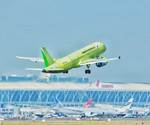First production Comac C919 narrowbody completes maiden flight, price higher than expected
China’s first narrowbody to compete with Boeing 737 and Airbus A320, the C919 nears entry into service and uses composites in common secondary structures.

Second C919 in maiden flight at Shanghai Pudong Intl. Airport, Dec. 2017. Photo Credit: Ken Chen, Wikicommons
As reported by Chen Chuanren for Aviation Week, China’s long-awaited, first domestically produced narrowbody airliner in the same class as the Boeing 737 and Airbus A320, achieved its maiden flight to and from Shanghai airport on May 14. Developed by Commercial Aircraft Corp of China (COMAC, Shanghai), the C919 is configured for 158-168 seats and a range of 4,075 to 5,555 kilometers. The aircraft — MSN007 — will be operated by Shanghai-based Chinese Eastern Airlines. It is the type’s launch customer and ordered five C919s in March 2021. China Eastern had expected to receive the first aircraft by the end of 2021, but delays in certification have forced the C919 entry into service back to late 2022.
On May 10, the company issued a stock exchange including plans to raise CNY15 billion ($2.2 billion) for the purchase of 38 aircraft comprising four C919 narrowbodies, 24 COMAC ARJ-21 regional jets, six Airbus A350-900 widebody jetliners and four Boeing 787-9 widebodies. Chuanren notes that this filing revealed the prices of the C919 and ARJ-21 for the first time — $99 million for each C919 and $38 million for each ARJ-21. The C919 price from state-owned COMAC is nearly twice industry estimate of $50 million that analysts had expected and puts the aircraft close to its Western peers — $121.6 million as a list price for a Boeing 737-8 and $110.6 million as a list price for an Airbus A320neo in Jan. 2018.
In 2017, composites material supplier Solvay (Alpharetta, Ga. U.S.) congratulated COMAC on the C919’s first flight and cited its long-term supply agreement for high-performance, structural composite and adhesive materials in the aircraft’s production.
- Nine prepreg specifications and seven adhesive specifications were qualified with Solvay products for the C919 program and are used across the aircraft’s structure.
- CYCOM977-2 and CYCOMX850 toughened epoxy prepregs are reportedly used on the horizontal stabilizer, rear pressure bulkhead, aileron and flaps.
- CYCOM970 and CYCOM7701 epoxy prepregs for honeycomb sandwich and monolithic structures are respectively used on the rudder, elevator, winglets, spoiler, wing-to-body fairings and on the radome.
- Various adhesives for metal and composite bonding were also selected.
Powered by two CFM Leap-1C engines, the C919 first flew in 2017 and COMAC has received 815 orders to date from 28 customers worldwide.
Related Content
-
PEEK vs. PEKK vs. PAEK and continuous compression molding
Suppliers of thermoplastics and carbon fiber chime in regarding PEEK vs. PEKK, and now PAEK, as well as in-situ consolidation — the supply chain for thermoplastic tape composites continues to evolve.
-
ASCEND program update: Designing next-gen, high-rate auto and aerospace composites
GKN Aerospace, McLaren Automotive and U.K.-based partners share goals and progress aiming at high-rate, Industry 4.0-enabled, sustainable materials and processes.
-
A new era for ceramic matrix composites
CMC is expanding, with new fiber production in Europe, faster processes and higher temperature materials enabling applications for industry, hypersonics and New Space.













